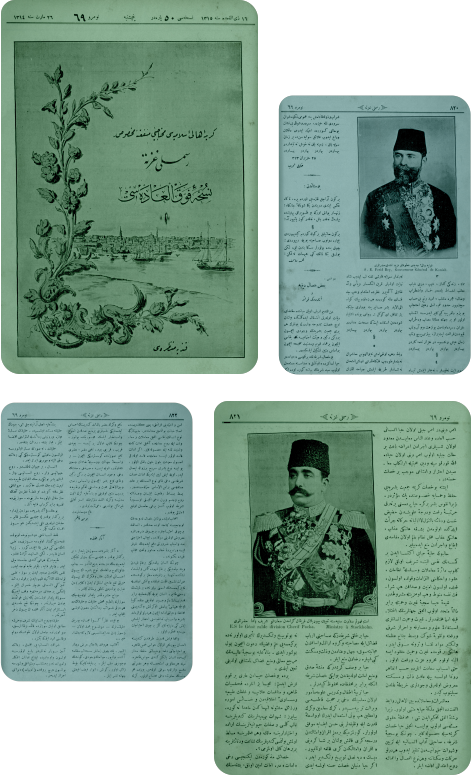A New Contribution to Türkiye’s Intellectual Life
İSAM Ottoman Turkish Articles Database

Bilgin Aydın
A New Contribution to Türkiye’s Intellectual Life
İSAM Ottoman Turkish Articles Database

Bilgin Aydın
The Centre for Islamic Studies (İSAM), which has played a pivotal role in the development of social sciences in Türkiye, also assumes a pioneering function in the preservation and revival of sources pertaining to the history of Ottoman print culture. Through its multifaceted activities—from library services to encyclopaedic and book publishing, from digital archival projects to bibliographic databases—İSAM not only facilitates the production of knowledge but also ensures its systematic recording, open accessibility, and transmission to future generations. Indeed, the mere publication of a study in any academic journal does not automatically render it accessible. If such publications are not consistently archived, monitored, or indexed by a dedicated library into searchable databases, the knowledge they contain risks being lost before even reaching the academic community. This issue is especially pressing in the case of periodicals, whose long-term preservation and circulation often remain inadequately addressed.
To meet these needs, İSAM compiled and made publicly available the bibliographic data of 534,000 academic articles produced over the past century in the field of social sciences in Türkiye, many of which were also offered in full text through topic-based databases. This initiative, offered without any subscription or payment requirements, significantly enhanced access to scholarly resources and marked a turning point in academic knowledge circulation within the social sciences. In this respect, it would not be an exaggeration to speak of a “before İSAM” and “after İSAM” era in terms of knowledge accessibility in Türkiye’s academic sphere.

Among İSAM’s most significant recent initiatives is the “Ottoman Turkish Articles Database.” Within this framework, thousands of articles published across hundreds of issues of approximately 87 different journals from the final fifty years of the Ottoman Empire have been made accessible. These journals, published primarily from the second half of the 19th century onward, are invaluable both for reflecting the intellectual landscape of their period and for bearing traces of the Ottoman modernization process. However, the integrity of these journal collections had long since been compromised; many issues were dispersed across different libraries or preserved in single copies. Recognizing this problem, İSAM digitized the most important of these journals dating from the 1860s and made their scholarly content available in PDF format. The availability of full-text PDFs of 45,873 articles from 87 Ottoman Turkish journals today must be regarded as an extraordinary advancement for Ottoman historiography, deserving of the highest commendation.

While some well-known journals such as Târîh-i Osmânî Encümeni Mecmuası are relatively accessible in print or in other archives, many others—whose very names had faded from scholarly memory—were notoriously difficult to locate, even for researchers based in Istanbul. Thanks to the Ottoman Turkish Articles Database, these sources can now be consulted with ease. Among the earliest examples included is Mecmûa-i Fünûn, which began publication under Münif Pasha’s supervision in July 1862 and continued for several years, producing 48 issues in total. Similarly, Ma‘lûmât, issued in 1894 by Mehmet Fuat and Artin Asaduryan, was published for two years and consisted of 48 issues. The latter is of particular importance as it was produced by the pioneers of the Edebiyât-ı Cedîde (New Literature) movement. Both journals are historically significant, not only as early examples of Ottoman periodical publishing but also as documents of the cultural and intellectual narratives surrounding Ottoman modernization.
With the launch of the Ottoman Turkish Articles Database, a wide array of journals from the second half of the 19th century—such as Ma‘lûmât, Maârif, Ulûm Gazetesi, Hürriyet, Dağarcık, Muharrir, Mecmûa-i Ulûm, Hazîne-i Evrâk, Mecmûa-i Ebüzziyâ, Âfâk, Mir’ât-ı Âlem, Cerîde-i Sûfiyye, İmdâdü’l-Midâd, Mecmûa-i Muallim, Mirsad, Resimli Gazete, Mütâlaa, Kānûn-ı Esâsî, Meşveret, Marifet, Mecmûa-i Lisân, İrtikā, and Mecmûa-i Edebiyye—have been consolidated in a single digital center and made available to researchers. This development constitutes a major milestone in improving the accessibility of Ottoman press history.
In addition to these efforts, İSAM Library has also made available, through its new library automation system, the PDFs of 55,551 pages from 545 distinct Ottoman Turkish periodicals. These two major undertakings have significantly facilitated access to primary sources not only for Ottoman historians but also for scholars working in fields such as art history, literature, and geography.
Through the Ottoman Turkish Articles Database, İSAM has constructed a comprehensive and systematic digital archive of Ottoman Turkish periodicals. This not only simplifies the work of researchers but also provides essential resources for those seeking to reconstruct the intellectual and publishing history of the Ottoman Empire. The database has helped uncover numerous texts forgotten for over 150 years and brought to light previously unknown authors and topics, thereby reintroducing them to the agenda of Turkish historiography. From this perspective, İSAM’s contribution goes beyond facilitating more robust research in Ottoman history—it also assumes the mission of making Türkiye’s knowledge resources globally accessible for scholarly inquiry.

 |
Prof. Dr. Bilgin Aydın Bilgin Aydın was born in 1969 in Beyşehir. He graduated from the Department of Archival Studies at the Faculty of Arts and Sciences, Marmara University, in 1993. In 1994, he began his academic career as a research assistant in the same department. He received his MA from the Institute of Turkic Studies at Marmara University in 1996 with a thesis titled “The Bureaucratic Structure and Document Administration of the Office of the Shaykh al-Islam during the Ottoman Modernization Period.” He completed his PhD in 2003 with the dissertation “The Emergence and Development of Divan-ı Hümayun Register Forms in Ottoman Bureaucracy (15th–16th Centuries).” He was awarded the title of Associate Professor in 2008 and became a Full Professor in 2013. He is currently the Head of the Department of Information and Records Management at Istanbul Medeniyet University, where he continues his academic work. His primary areas of research include the history of archives and the bureaucratic history of the Ottoman Empire. |

Prof. Dr. Bilgin Aydın
Bilgin Aydın was born in 1969 in Beyşehir. He graduated from the Department of Archival Studies at the Faculty of Arts and Sciences, Marmara University, in 1993. In 1994, he began his academic career as a research assistant in the same department. He received his MA from the Institute of Turkic Studies at Marmara University in 1996 with a thesis titled “The Bureaucratic Structure and Document Administration of the Office of the Shaykh al-Islam during the Ottoman Modernization Period.” He completed his PhD in 2003 with the dissertation “The Emergence and Development of Divan-ı Hümayun Register Forms in Ottoman Bureaucracy (15th–16th Centuries).” He was awarded the title of Associate Professor in 2008 and became a Full Professor in 2013.
He is currently the Head of the Department of Information and Records Management at Istanbul Medeniyet University, where he continues his academic work. His primary areas of research include the history of archives and the bureaucratic history of the Ottoman Empire.
